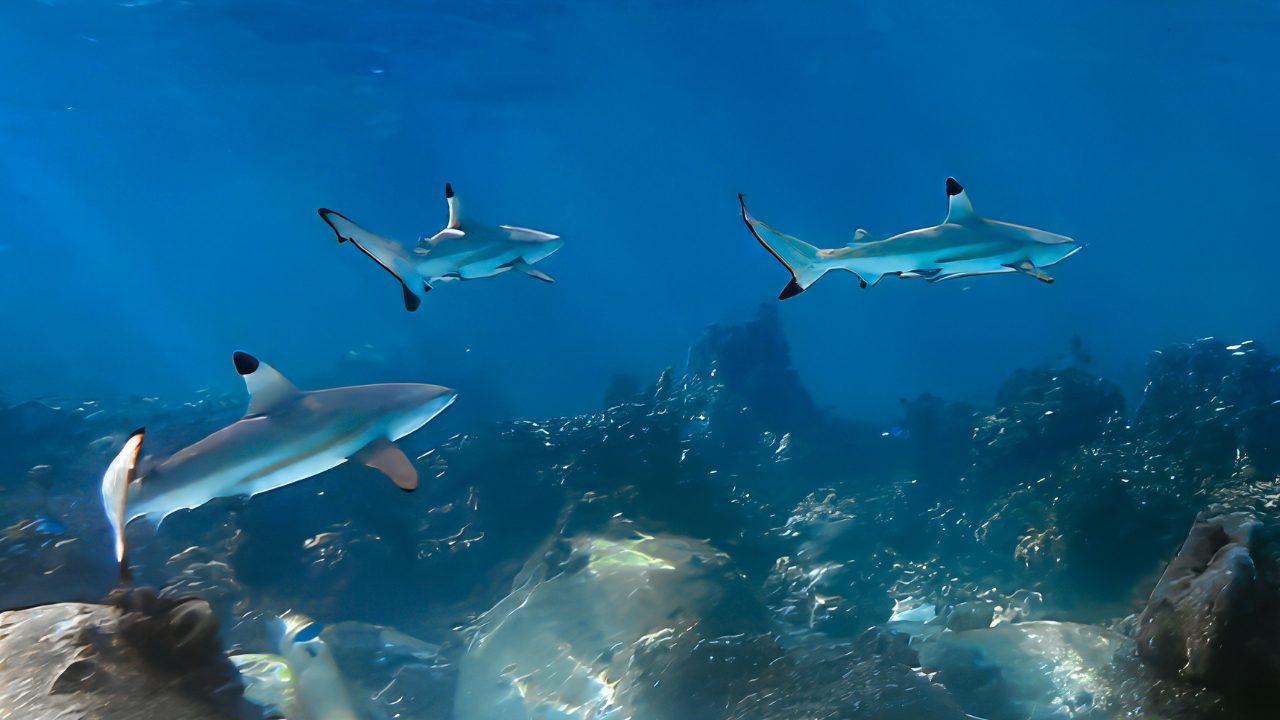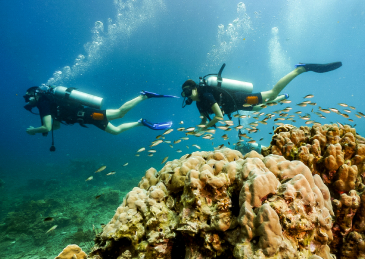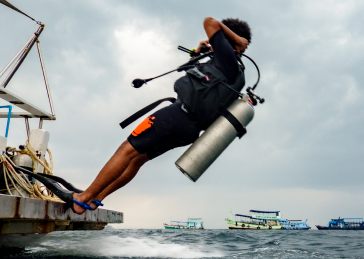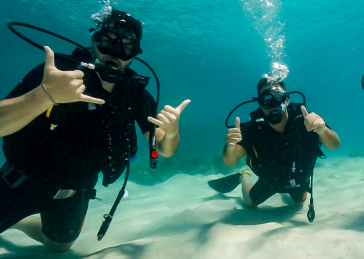17th May 2025
Blacktip Reef Sharks of Koh Tao: Graceful Guardians of Thailand’s Coral Paradise
Main Points
- Blacktip reef sharks (Carcharhinus melanopterus) are an iconic species found in the shallow waters surrounding Koh Tao, instantly recognizable by the distinctive black tips on their fins.
- These elegant predators play a vital role in maintaining the health and balance of Koh Tao’s coral reef ecosystems.
- Several dive sites around Koh Tao offer reliable opportunities to observe blacktip reef sharks in their natural habitat.
- Conservation efforts are crucial to protect these vulnerable sharks, which face various threats despite their protected status in Thai waters.
Introduction to Koh Tao’s Resident Sharks
The warm tropical waters surrounding Koh Tao harbor one of the ocean’s most perfectly designed predators – a creature whose streamlined silhouette has remained virtually unchanged for millions of years. The blacktip reef shark (Carcharhinus melanopterus), with its distinctive black-tipped fins cutting through the azure waters, represents both the beauty and fragility of the marine ecosystems encircling this tropical Thai island.
Unlike the exaggerated portrayal of sharks in popular media, blacktip reef sharks around Koh Tao offer divers and snorkelers the chance to witness the true nature of these magnificent animals – elegant, cautious, and fundamentally important to the health of coral reef systems. For many visitors to the island, an encounter with these graceful predators becomes a highlight of their underwater adventures and often transforms preconceived notions about sharks into appreciation and respect.
The Blacktip Reef Shark: Design Perfection

Physical Characteristics and Identification
Blacktip reef sharks are medium-sized sharks, typically reaching 1.5-1.8 meters (5-6 feet) in length around Koh Tao, with females generally growing larger than males. Their slender, streamlined bodies epitomize evolutionary perfection for their ecological niche – fast, efficient hunters adapted to navigate the complex topography of coral reef environments.
The feature that gives them their name – and makes them instantly recognizable even to novice divers – is the prominent black marking on the tips of their dorsal, pectoral, pelvic, and caudal (tail) fins. This distinctive coloration contrasts beautifully against their grayish-brown upper body and white underside, a classic example of countershading camouflage that helps them hunt effectively and avoid their own predators.
Their snout is relatively short and rounded compared to other shark species, housing rows of serrated teeth designed for grasping and cutting rather than crushing. Perhaps their most striking feature when observed up close is their large, expressive eyes, which provide excellent vision – a reminder that these are highly aware, sensory-developed animals rather than the mindless predators often portrayed in popular culture.
Young blacktip reef sharks around Koh Tao appear almost identical to adults from birth, just smaller in scale – a miniature version of their parents complete with the signature black-tipped fins that serve as their namesake.
Behavior and Habitat Preferences
Around Koh Tao, blacktip reef sharks display consistent behavioral patterns that make them relatively predictable for observers who understand their habits. They’re primarily active during daylight hours (diurnal), though crepuscular (dawn and dusk) activity peaks are common as these transition times often align with feeding opportunities.
They typically prefer shallow, warm waters ranging from 1-15 meters in depth, with particular affinity for areas that combine coral reef structures with sandy patches and seagrass beds. This habitat preference makes the fringing reefs surrounding Koh Tao ideal territory, offering the varied underwater landscape these sharks favor.
Social structure among blacktip reef sharks is more complex than many people realize. While not truly schooling by definition, they frequently form loose aggregations, particularly in protected bays and lagoons. Around Koh Tao, it’s not uncommon to observe small groups of 3-7 individuals patrolling the same area, especially at sites like Shark Bay and Tanote Bay on the island’s eastern side.
Hunting and Feeding Strategies
Blacktip reef sharks are active predators that employ a distinctive hunting strategy well-suited to the reef environment. Unlike some shark species that rely on ambush or scavenging, blacktips actively patrol their territory, using their excellent vision to locate prey, which primarily consists of small reef fish, crustaceans, cephalopods (octopus and squid), and occasionally sea snakes.
What makes blacktip reef sharks particularly fascinating to observe is their cooperative hunting behavior. When targeting schools of small fish, multiple sharks sometimes work together to herd prey into shallow waters or coral structures where escape becomes difficult. This level of coordination suggests more sophisticated social behavior than they’re often credited with.
Despite their predatory nature, blacktips are surprisingly selective feeders, typically consuming only 0.3-0.9% of their body weight daily – far less than many people imagine sharks eat. This measured consumption is one of many indications that they are not the insatiable predators of popular imagination but rather calculated hunters playing a precise ecological role.
Encountering Blacktip Reef Sharks Around Koh Tao

Prime Locations for Shark Observations
Several locations around Koh Tao have earned reputations as reliable spots for blacktip reef shark encounters:
Shark Bay: Despite the commercial-sounding name, this bay on Koh Tao’s eastern side genuinely lives up to its moniker, hosting a resident population of blacktip reef sharks. The combination of sandy bottom and scattered coral heads creates ideal conditions for these sharks, particularly in the morning hours. Its relatively protected position makes it accessible to both divers and snorkelers when conditions permit.
Sai Daeng: This south eastern bay offers excellent opportunities for blacktip encounters, particularly for snorkelers willing to venture a bit further from shore. The deeper central channel of this bay serves as a highway for blacktips moving between feeding areas.
Aow Leuk: Just slightly north of Sai Daeng, Aow Leuk gives fantastic opportunities to see baby blacktips during early morning or late afternoon snorkeling.
For more information on the top dive sites of Koh Tao, click here.
Timing and Conditions for Optimal Sightings
Successful blacktip reef shark encounters around Koh Tao correlate strongly with specific timing and conditions:
Time of Day: Early morning (6:30-9:00 AM) consistently provides the highest probability of sightings, as sharks are often most active during these hours. Late afternoon (4:00-6:00 PM) offers a secondary window of opportunity when they typically increase activity before nightfall.
Seasonal Variations: While blacktips are present year-round, the period from February to May typically yields the most consistent sightings around Koh Tao. This timeframe coincides with slightly warmer water temperatures and often clearer visibility on the island’s eastern side.
Weather Conditions: Calm surface conditions not only improve visibility but also make it easier to spot sharks from the surface when snorkeling. After periods of rough weather, shark sightings often temporarily decrease, possibly due to their sensitivity to barometric pressure changes or sediment suspension in the water.
Observation Tips and Responsible Interaction

Meaningful encounters with blacktip reef sharks depend heavily on appropriate human behavior:
Minimize Entry Disturbance: When entering areas known for blacktip presence, do so gently and quietly. Loud splashing and sudden movements often cause these naturally cautious animals to retreat temporarily.
Maintain Distance: Respect for these animals means giving them space – the general recommendation is staying at least 3-4 meters away from any shark. This distance ensures both human safety and minimizes disturbance to natural shark behavior.
Move Slowly and Deliberately: Quick or erratic movements can trigger a startle response or be misinterpreted as prey behavior. Calm, steady movements allow for longer and more natural observations.
Never Chase: Following or pursuing sharks creates stress and disrupts natural behavior patterns. Instead, position yourself appropriately and allow the sharks to determine the nature of the encounter.
No Touching: Beyond the obvious safety concerns, physical contact can damage the protective mucus layer on shark skin that helps prevent infection.
No Feeding: Artificial feeding fundamentally alters natural behavior patterns and can create problematic associations between humans and food. All reputable dive operations around Koh Tao strictly prohibit shark feeding.
Group Management: When diving or snorkeling in groups, stay together in a compact formation rather than spreading out across a wide area, which can make sharks feel surrounded and threatened.
Ecological Importance and Conservation

Conservation Challenges
Despite their protected status in Thai waters since 2015, blacktip reef sharks around Koh Tao and throughout the Gulf of Thailand face multiple threats:
Fishing Pressure: While direct targeting of sharks is illegal, incidental capture as bycatch in fishing operations targeting other species continues to impact populations. Their preference for shallow coastal habitats makes them particularly vulnerable to near-shore fishing activities.
Habitat Degradation: The coral reef ecosystems that blacktips depend on face numerous challenges including coral bleaching, sedimentation from coastal development, physical damage from boat anchors, and pollution. Each of these factors reduces the carrying capacity of the environment for supporting healthy shark populations.
Low Reproductive Rate: Like most shark species, blacktip reef sharks have a relatively slow life history strategy – reaching sexual maturity at 4-5 years, having gestation periods of 10-11 months, and producing only 2-5 pups per litter. This reproductive pattern makes population recovery slow once numbers decline.
Tourism Impact: While tourism creates economic incentives for protection, poorly managed marine tourism can disrupt natural behaviors, particularly in shallow nursery areas where juvenile sharks develop.
Climate Change: Rising ocean temperatures and acidification impact both sharks directly and the reef ecosystems they depend on, creating potential long-term threats to their survival.
For more information on marine conservation Koh Tao, click here.
Local Conservation Efforts

Encouragingly, several initiatives around Koh Tao are working to protect the island’s blacktip reef shark population:
Shark Monitoring Programs: Organizations like the New Heaven Reef Conservation Program conduct regular population surveys using photo identification techniques to track individual sharks and monitor population trends.
Marine Protected Areas: Several bays around Koh Tao have been designated as protected zones with restricted fishing activities, creating safe havens for resident shark populations.
Education and Awareness: Local dive centers increasingly incorporate shark conservation education into their programs, transforming divers from mere observers into informed advocates for marine protection.
Swim For Sharks: An annual Koh Tao fund raising event to help sustain shark populations around Koh Tao.
Sustainable Tourism Practices: Guidelines for responsible shark encounters have been developed and widely adopted by Koh Tao’s dive operations, minimizing tourism impact while maximizing the educational value of shark observations.
Artificial Reef Projects: Strategic placement of artificial reef structures around the island aims to expand available habitat and create additional prey refuge areas that support the food chain blacktips depend on.
For more information on shark conservation Koh Tao, click here.
Life Cycle and Reproduction

Mating and Pupping Behaviors
The reproductive cycle of blacktip reef sharks represents one of the most fascinating aspects of their biology, though observations of mating behaviors around Koh Tao remain relatively rare.
Like most sharks, blacktips utilize internal fertilization, with males possessing specialized claspers (modified pelvic fins) for transferring sperm to females. The mating process itself can be somewhat rough, with males often biting females’ fins or flanks to maintain position during copulation – a behavior that sometimes leaves visible but temporary scarring on mature females.
What makes blacktip reproduction particularly interesting is their use of specific nursery areas – typically very shallow, protected lagoons or bay margins where pregnant females give birth to live young (viviparous reproduction). These nursery zones provide young sharks with abundant food resources and protection from larger predators during their vulnerable early months.
Around Koh Tao, certain protected shallow areas within Shark Bay and parts of Aow Leuk have been identified as potential pupping grounds, with observations of neonate (newborn) sharks with visible umbilical scars occasionally reported during the February to April period, suggesting seasonal breeding patterns.
Unlike some shark species that have large litters, female blacktips typically give birth to just 2-5 pups after a gestation period of 10-11 months. These young sharks emerge fully formed at approximately 50-60 cm in length, miniature versions of their parents complete with the distinctive black-tipped fins, though their markings may appear more pronounced in youngsters.
Frequently Asked Questions
1. Are blacktip reef sharks dangerous to swimmers and divers around Koh Tao?
Blacktip reef sharks pose minimal risk to humans in the waters around Koh Tao. Despite their predatory nature, these sharks are naturally cautious around people and typically maintain their distance or swim away when encountering divers or snorkelers. The International Shark Attack File has recorded very few incidents involving this species worldwide, with most being minor and provoked by human actions such as spearfishing nearby or attempting to handle the sharks.
2. What’s the best time and place to see blacktip reef sharks while visiting Koh Tao?
For the highest probability of encountering blacktip reef sharks around Koh Tao, early morning (6:30-9:00 AM) visits to Shark Bay on the island’s eastern coast provide the most reliable sightings. This protected bay features a shallow, sandy bottom with scattered coral heads that creates ideal habitat for resident blacktips. The morning hours are crucial, as human activity later in the day often causes the sharks to temporarily retreat to deeper water. Early morning or late afternoon trips to Aow Leuk Bay and Sai Daeng also frequently yield blacktip sightings. During the February to May period, shark activity typically increases around the island, possibly corresponding with breeding behaviors. Visitors should arrange their excursions through reputable operators that emphasize responsible wildlife interaction and avoid crowded times. Calm sea conditions further improve sighting opportunities, as clear water makes spotting these sometimes shy creatures much easier, particularly for snorkelers observing from the surface.
3. How can I distinguish between baby blacktip reef sharks and adults while snorkeling or diving?
Juvenile blacktip reef sharks around Koh Tao can be distinguished from adults through several key characteristics. Size provides the most obvious indicator—newborn blacktips typically measure 50-60 cm in length, while mature adults reach 1.5-1.8 meters. Beyond size, juvenile blacktips often display more vivid and proportionally larger black markings on their fins compared to the somewhat faded markings on older individuals. Behaviorally, young sharks tend to remain in very shallow water (less than 3 meters deep) and exhibit more cautious movements, frequently using seagrass beds or shallow reef patches as cover when feeling threatened. They also tend to stay closer to the protection of shorelines, particularly in designated nursery areas within Shark Bay and parts of Aow Leuk. Newly born pups (neonates) may additionally show a visible umbilical scar on their undersides for the first few weeks of life. Most juvenile sightings occur in small groups of similar-sized individuals, while larger adults are more frequently observed either solitarily or in loosely associated pairs.
4. Why are blacktip reef sharks important to Koh Tao’s marine ecosystem?
Blacktip reef sharks perform several vital ecological functions that maintain the health and resilience of Koh Tao’s coral reef ecosystems. As mid-level predators, they help regulate populations of smaller reef fish through predation, preventing any single species from becoming overly dominant and potentially disrupting the delicate balance of the reef community. Their hunting behavior influences prey distribution and behavior patterns across the reef, creating what ecologists call a “landscape of fear” that helps maintain biodiversity through behavioral effects. By preferentially targeting slower or diseased individuals, blacktips remove genetically weaker specimens from prey populations, strengthening the overall gene pool.
5. What conservation efforts are in place to protect blacktip reef sharks around Koh Tao?
Several coordinated conservation initiatives work to protect Koh Tao’s blacktip reef shark population and their habitat. At the national level, Thailand’s 2015 shark fishing ban provides legal protection, prohibiting the targeting, capture, or sale of all shark species in Thai waters. Locally, community-driven efforts include the annual “Swim For Sharks” fundraising event, and the designation of specific marine protected zones around the island where fishing activities are restricted. The New Heaven Reef Conservation Program conducts regular population monitoring using photo identification techniques, creating a database of individual sharks that helps track population trends and movement patterns. Educational outreach by dive centers and conservation organizations raises awareness among visitors and locals about shark conservation, transforming perception from fear to appreciation. Artificial reef projects strategically placed around the island help expand available habitat and create additional prey refuge areas that support the food chain blacktips depend on. Beach and underwater cleanup initiatives reduce marine debris that can entangle or harm sharks. Additionally, the dive industry has widely adopted responsible wildlife interaction guidelines that minimize tourism impacts while sharing the conservation message with thousands of visitors annually.
Dive with LBD: Your Gateway to Underwater Exploration
Whether you’re a curious beginner or a seasoned pro, our school is your portal to the wonders of scuba diving. Join us into the world beneath the waves.
READY TO GET STARTED?
Check our diving courses in Koh Tao



